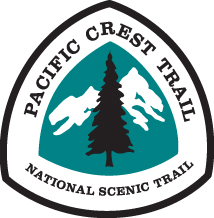 |
| Walking along the LA Aqueduct. Photo Courtesy of Jane Boer |
I've heard it hundreds of times from fellow hikers: "Road walking sucks! I hated hiking alongside the LA Aqueduct on the PCT. I would love to hike the PCT again but not the desert with all its wind farms and dirt roads." I've heard it as a warning during my preparations for my CDT thru-hike this year. "Be prepared for some long road walk sections." And when I talk to westerners about hiking the Appalachian Trail I often hear: "I don't have any interest in hiking so close to civilization through those tiny hills."
Listening to these sentiments, I realize that my goals are different from many other hikers. It seems that there are a large number of people who wish for a human-less experience in the backcountry. A lot of folks just want to see the rare beauty that comes from remote areas infrequently visited by other hikers. I love this too, so deeply, but I also love learning and feeling connection to our true relationship with the land. I want to feel the full force of our actual impact. I want to learn, not simply entertained.
My friend Dirtmonger and I have had some wonderful conversations along these same lines. A fantastic article of his was recently published on Gossamer Gear's blog. In this article, Dirtmonger tells the story of trespassing on federal lands during the recent government closure. He explains his thought process and rationale for disregarding the closure and continuing on with his adventure. This controversial article has received a large number of responses and in one of these critical retorts it was written:
"And last, there are these things called mountain bikes. They make dirt roads into something other than a sisyphian exercise in neolithic absurdity."
 |
| Dirt Road Fun on the PCT. Photo Courtesy of Jane Boer |
It's through the liminal space between urban, rural and wilderness that the biggest lessons reveal themselves. I love walking on High Sierra granite. I love dusty dirt roads. I love sandy beaches and paved city streets and railroad beds and walking just about anywhere. Any time a car passes or I catch someone's smile I feel like a superhero and a time traveller; walking without insulation, as naked to the world as possible in a land and time dominated by vehicles. I feel like a coyote trotting along the seams of civilization, free to sleep just about anywhere. I know I can survive in just about any circumstance. This is freedom! Walking is my way of life, it heals me spiritually, emotionally and physically; it provides balance and perspective. Walking is not just some activity I do to complete a long trail. Walking brings me the deepest joys and sorrows; it is love.
I've also been trying to incorporate my adventures as organically as I can into the framework and flow of the rest of my life. Last week I walked a 90+ mile loop between my house in Loma Mar and Santa Cruz. I visited friends along the way and pieced together single track, dirt roads, paved roads, ocean beaches and railroad beds. It was a so much fun to choose the route as I progressed. The uncertainty created the sense of adventure I had been craving. To see this land from a new perspective was enlightening. I was not in the wilderness in the traditional sense but I had a blast!
Right now, I'm home for the holidays with my family in Baltimore. What better opportunity to walk the border of my birth state and develop a better sense of place in my birth land? Not to mention the historical and ecological context described in the previous post.
To take things one step further; there are days that I dream of leaving all petroleum transportation behind. I want to live a human powered existence. I'm sure the challenges would be huge, but so would the rewards. The day may come when I'm ready to fully immerse myself in this lifestyle, "but it will not be this day."
A huge inspiration, John Francis chose to live without motorized vehicles for 22 years. 17 of those years he was silent. You can watch his incredible TED talk here.
So what are some of my ingredients for meaningful challenge and adventure?
1. Attempt something you've never done before. Set goals and intentions.
2. Stay open to connecting with the land no matter what the environment.
3. Talk to the people you encounter and learn their stories.
4. Embrace uncertainty and impermanence.
5. Accept the moment for what it is without judgement.
6. Try to stay as positive and authentic as possible.
7. Remind yourself that "beauty is everywhere."
Having absolutely loved my walking adventures in a full range of environments, from city streets to remote alpine ranges, it's no wonder that I would be willing to take on 184.5 flat miles of walking meditation. Plus, an entire journey taking place deep in a river valley in the middle of winter has its own unique challenge and lessons. There's a lot to be learned and I'll address these special concerns in the next post.








































